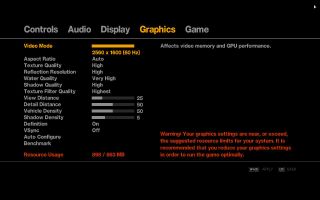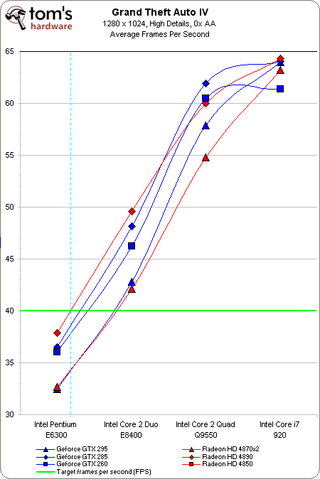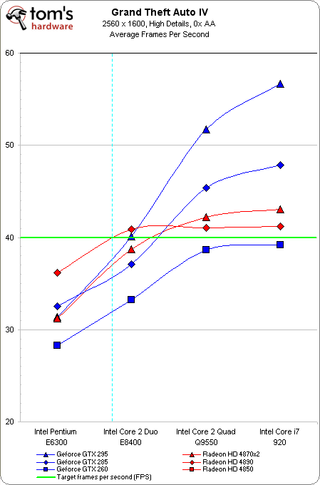Part 1: Building A Balanced Gaming PC
Benchmark Results: Grand Theft Auto IV
Grand Theft Auto IV

The amount of available memory for each graphics core determines the detail levels Grand Theft Auto (GTA) IV allows to be used. Rather than bypassing this constraint, we basically cranked settings for the 896MB per GPU available on the GeForce GTX 260 and GTX 295. Note that, here, if you were using cards with 1GB per graphics processor, you could further raise Shadows to Very High and set view distance to 30%.
Even at the lowest resolution, the Radeon HD 4850, with only 512MB of memory, needed to be omitted from GTA IV testing.
I was totally new to the GTA series when I started work on this project. But having heard the voices of readers wanting to see this game added to the benchmark suite, I obliged. The first order of business was to play the game on various configurations and get accustomed to the expected performance and hardware requirements. We again use the game’s built-in benchmark and shoot for a target of 40 FPS. Some time spent playing on our tested platforms indicated that systems capable of reaching this target were at least playable, providing 30+ FPS during intensive game play, with just the occasional dip into the mid 20s. Whether in-game or running the benchmark, GTA IV doesn’t seem push graphics cards all that hard.

A quick glimpse at this chart is all that it takes to see GTA IV is the most CPU-limited game we have visited thus far. It’s also obvious that the game takes advantage of more than two processer cores. A closer look reveals the two dual-GPU cards actually trail behind at this low resolution.
The stock 2.8 GHz Pentium E6300 doesn’t have a shot at competing here. While the GeForce GTX 260 and Core 2 Duo E8400 are the cheapest pair to hit the target, we also see it takes a pairing with one of the quad-core chips before we call a GeForce GTX 260-based platform balanced.

The CPU bottleneck continues, and despite slightly lower results for the GeForce GTX 260, our recommendations remain the same.
Stay on the Cutting Edge
Join the experts who read Tom's Hardware for the inside track on enthusiast PC tech news — and have for over 25 years. We'll send breaking news and in-depth reviews of CPUs, GPUs, AI, maker hardware and more straight to your inbox.

Other cards start feeling some pressure and the GeForce GTX 295 eventually climbs to the top. But overall, for a third straight resolution, our hardware recommendations remain the same. Note how CPU-limited we still are at 1920x1200; the y-axis scale still doesn’t even need adjusting.

At 2560x1600, the GeForce GTX 260 can no longer reach the target frame rate, while its bigger GeForce brothers easily take the top honors and deserve attention. The Radeon HD 4870 X2 doesn’t look as impressive here as in other games, but the Radeon HD 4890/E8400 combo manages to be the cheapest and most balanced minimum solution we can recommend at this resolution.
Current page: Benchmark Results: Grand Theft Auto IV
Prev Page Benchmark Results: S.T.A.L.K.E.R.: Clear Sky Next Page Benchmark Results: Fallout 3-
yoy0yo Wow, this is an amazingly in depth review! I kinda feel that its sponsered by Asus or Corsair, but I guess you kept with the same brand for the sake of controls etc.Reply
Thankyou! -
inmytaxi Very helpful stuff.Reply
I'd like to see some discussion on the availability of sub $400 (at times as low as $280) 28" monitors. At this price range, does it make more sense to spend more on the LCD even if less is spent initially on graphics? I would think the benefit of 28" vs. 22" is so great that the extra money could be taken from, say, a 9550 + 4890 combo and getting a 8400/6300 + 4850 instead, with the right motherboard a second 4850 later will pass a 4890 anyway. -
frozenlead I like the balance charts. It's a good way to characterize the data. This article is well constructed and well thought-out.Reply
That being said - is there a way we can compile this data and compute an "optimized" system for the given hardware available? Finding the true, calculated sweet spot for performance/$ would be so nice to have on hand every quarter or twice a year. I'll have to think about this one for a while. There may be some concessions to make, and it might not even work out. But it would be so cool. -
Neggers I feel like the person that did this review got it finished alittle bit late. I can only assume he did all the testing some months back and has only just finished writing up his results. But its sad to not see the new P55/i5 Systems, AMD Athlon II Quad Cores, or the Radeon 5000 series.Reply
Good review, but hopefully it can be updated soon with some of the newer equipment thats out, to turn it into a fantastic guide for people. -
brockh Great job, this is the information people need to be seeing; the way people provide benchmarks these days hardly tells the story to most of the readers. It's definitely important to point out the disparities in ones CPU choice, rather than just assuming everyone uses the i7 all the sites choose. ;)Reply
Looking forward to part 2. -
Onyx2291 This will take up some of my time. Even though I know how, it's nice to get a refresher every now and then.Reply -
mohsh86 you are really kidding me by not considering the ATI 5000 series, although am a fan of nvidia , but this is not fair !Reply
Most Popular

